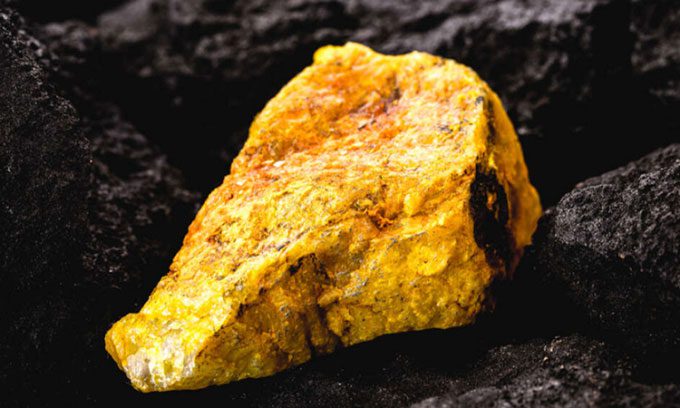The ability to store and release energy explosively makes uranium highly applicable, especially in nuclear weapon production.
Uranium is one of the heaviest naturally occurring elements. Its nucleus contains 92 protons and a varying number of neutrons, ranging from 140 to 146. However, only a few combinations occur spontaneously, the most abundant being uranium-238 (92 protons and 146 neutrons) and uranium-235 (92 protons and 143 neutrons).

A block of uranium excavated from nature. (Photo: R.H.J photo and illustration)
Uranium can only be formed in certain extreme events, known as the r-process, which occurs during intense cosmic explosions such as supernovae or neutron star collisions. From these explosions, it spreads throughout the universe and becomes an essential component of Earth, albeit very rare. The presence of decaying uranium is the reason our planet has internal heat.
This is a crucial characteristic of uranium. Over time, it emits radiation in the form of helium atoms, transforming into thorium. Most uranium isotopes (versions with different neutron counts) have very long half-lives (the time it takes for a sample to reduce its uranium content by half). Uranium-238 has a half-life of up to 4.5 billion years.
Uranium has been used since Roman times as a yellow glaze in ceramics and glass. In 1789, German chemist Martin Heinrich Klaproth mixed nitric acid with a solid and then neutralized the solution with sodium hydroxide. This reaction produced a yellow substance that sank to the bottom.
When heated with coal, it transformed into a black powder that Klaproth mistakenly thought was pure uranium, but it was likely an oxide. He named this new element after the planet Uranus, which had been discovered just 8 years earlier by William Herschel. It wasn’t until 1841 that the first pure sample of uranium was successfully isolated by chemist Eugène-Melchior Péligot.
Today, uranium is no longer used for coloring glass and glazes; instead, its primary application lies in its radioactivity, discovered by Henri Becquerel in 1896.
Four decades later, in 1934, a group of Italian physicists led by Enrico Fermi bombarded uranium with neutrons and observed it emitting electrons and positrons (the antimatter counterpart of electrons). Subsequent research by Otto Hahn, Fritz Strassmann, Lise Meitner, and Otto Robert Frisch demonstrated that uranium can decay into lighter elements and named this process nuclear fission. This is what makes uranium a “game changer.”
One kilogram of uranium-235, if fully subjected to fission, can release chemical energy equivalent to burning 1.5 million kilograms of coal. This explosive energy storage and release capability has enabled the use of this element in electricity generation and nuclear weapons like atomic bombs.
In nuclear power plants, the radioactive emissions from uranium fuel rods heat a coolant, and the resulting heat then warms water in another container, turning it into steam. The steam drives the turbines of generators to produce electricity, and importantly, this process does not generate greenhouse gas emissions.
In both cases, natural uranium is not ideal for many reactors. More than 99.2% of uranium mined on Earth is uranium-238, while uranium-235 only accounts for 0.711%. Uranium-235 creates a very efficient nuclear reaction chain, helping to maintain a stable reaction. However, we need enough of this isotope in the fuel rods of the reactor. That is when uranium needs to be enriched, through the isotope separation process to increase the percentage of uranium-235.
The remainder of the enrichment process produces depleted uranium (which has less uranium-235). It is utilized as containers for transporting radioactive materials, in industrial radiographic equipment, as well as for military purposes such as armor-piercing coatings and projectiles.





















































